8 essentials for skiers and snowboarders, according to an expert
Gear up to fly down the slopes in style.
Products are chosen independently by our editors. Purchases made through our links may earn us a commission.
The most optimistic of ski and snowboard enthusiasts will tell you that there are few things you need to enjoy a day on the slopes, other than a good attitude and a basic understanding of how to get on and off a ski lift. But the truth is, this snow sport does require a lot of stuff (independent of the skis and poles they rent you at the mountain), especially when you’re first starting out. Being properly equipped on your first few mountaintop excursions can make all the difference between becoming a lifetime ski bum and a thanks-but-I'll-sit-by-the-fire-in-the-lodge type. Here are the essentials to bring with you if you’re hitting the slopes this year, according to an expert.
Layers matter—choose them wisely
You may have heard this before, but it bears repeating: To enjoy outdoor activities, opt for light, breathable layers. Wearing them helps keep your core warm, but also prevents sweat from stagnating beneath your winter coat. “You want to make sure you're warm enough, but also need to manage moisture,” says Dave Beckwith, director of Snow Sports at Killington Ski Resort in Vermont. “Moisture wicking layers are essential for skiing and riding.”
A great ski or board day starts with your feet. “Make sure you have a good wool or synthetic sock that will move the moisture away from your body,” Beckwith says. The socks should be taller than your boots and not too thick—and if they're too tight on your feet (in an unintentional, non-compressive way), you will get colder faster.
You should also wear a thin, moisture-wicking base layer of long underwear or tights and a thermal top on your legs and upper body. Look for options made of wool or synthetics engineered for cold-weather activity, which keep your body heat close and sweat at bay. For these layers, Beckwith says to avoid cotton, which absorbs sweat and can cause irritation when it rubs against the skin.
To keep everything insulated, your next layer should be lightweight but warm. Fleece or wool is best for its superior air-trapping capabilities, but because it won’t be directly against your skin, a regular sweatshirt is fine if you have one you like.
Finally, you’ll want wind and waterproof outer layers, including pants and a jacket. Any pair of athletically inclined snow pants should work, either with a typical belted rise or with an overall-style bib, which provides some extra protection between you and the snow on messy days. For your top half, make sure the jacket you pick is suitable for the weather and your accessories. “It's best to have a jacket with a high collar and a hood to protect your face and head,” Beckwith says. “Make sure that your jacket can accommodate a helmet.”
But don’t skip these accessories
Speaking of helmets, most ski resorts have rentals, so you don’t need to buy one. (They’re bulky and difficult to slip into a carry-on, after all.) But if the resort you’re going to doesn’t offer them, or you don’t want to use a rental, you’ll want to make sure you still have one—protecting your head against injury is vital. If you’re buying one, consider the classic ski and snowboard brands you’ll probably see in resort’s shop—Giro, Smith, and Oakley.
Your ski helmet will help keep your head warm, but for an extra layer of protection, add a gaiter (which covers your neck and the lower half of your face) or balaclava (which covers your neck, lower half of your face, and your ears and head) made of wool or fleece. “As far as accessories, these are terrific pieces to protect your face and create warmth for your head inside a helmet,” Beckwith says.
You can wear any kind of glove or mitten on your hands as long as it’s waterproof and insulated. But for maximum warmth, Beckwith is partial to mittens. “[They] work very well, and can easily accommodate hand warmers for extra warmth if needed,” he says. If you want more dexterity, get a pair of flip-top or zippered mittens with a gloved lining on the inside.
Last but not least, you’ll want sunglasses or goggles to protect your eyes against the glare of the sun and and any snow or ice blowing around. According to Beckwith, goggles are the way to go—they have elastic that holds them tight to the back of the head, ensuring they don’t slip down your nose during the day, and they offer more protection for the eye area. When searching for goggles, look for ones with anti-fogging features and UV protection. Just make sure you buy them far enough in advance that you have time to check their fit before you get on the ski lift—you don’t want them sliding off or pinching your face when you’re halfway down the mountain.
Consider bringing these along
Hand warmers serve a dual purpose on a ski slope. They prevent your fingers from going numb when tucked in a pair of gloves or mittens—and, if you keep one close to your cell phone, you may prolong its battery life, as cold weather can sap your phone’s power. If you want to be safe, consider bringing a portable charger, like an Anker PowerCore. “It’s not a bad idea to carry one,” Beckwith says. “You don't want your phone to die and miss that photo opportunity!”
Also: Don’t forget your SPF. It may feel cold outside, but UV levels are higher at high elevations, according to the World Health Organization, which means your risk of sunburn rises when you get on a ski lift. True, you won’t have that much skin exposed, but keeping a mini facial sunscreen and lip balm—ideally with SPF 30 or more—in your jacket pocket during the day will prevent you from leaving the mountain with itchy, red, peeling skin.
What to leave behind
This may go without saying, but try to avoid taking anything that isn’t essential on the mountain, like dangly metal jewelry and heavy backpacks. “Metal jewelry will conduct the cold, whether it be on your ears or even fingers,” Beckwith says. Plus, rings and earrings can snag on gloves and hats, and ankle bracelets may not feel great when they’re pressed against a tight ski or snowboard boot.
If you want, you can bring a lightweight backpack or waist pack with room for a small water bottle, some snacks, and your wallet, but it’s not necessary—and, if you do, make sure you don’t overload it. “You do not want to limit your range of motion or mobility on the slopes,” Beckwith says. “The more freedom of movement and overall comfort you have, the more you’ll enjoy your experience.”
Your shopping list for the perfect day on the slopes
1. Wool socks to keep your feet warm
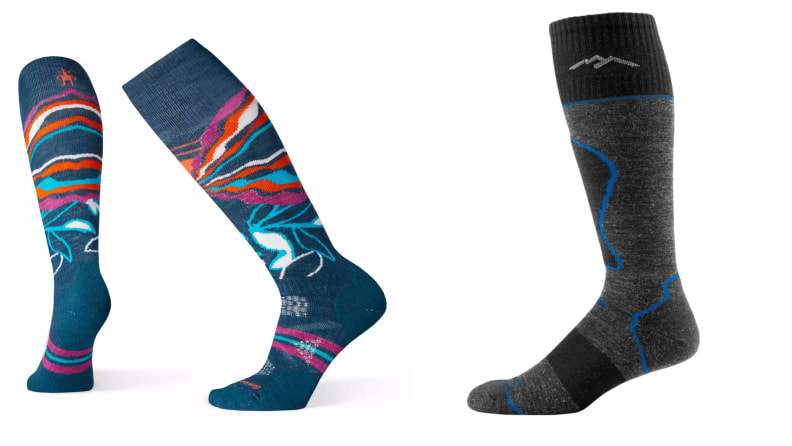
Wool socks keep your feet toasty all day.
Merino wool socks from Smartwool and Darn Tough provide lightweight insulation that keeps you comfy all day. Both brands offer many different colors and styles, so you’re covered when it comes to personal expression. Make sure you get a pair that doesn’t feel too thick or tight, which can make your feet feel colder faster.
“I've had padded socks before and I've gotten by skiing but these absolutely changed my experience,” writes a reviewer of the Darn Tough socks. “I’ve skied since I was a kid and I've always had shin problems. When I used these socks, I didn't notice my shins all day! Comfortable and warm.”
- Get men’s and women’s PhD socks from SmartWool starting at $26.95
- Get men’s and women’s ski socks from Darn Tough starting at $25
2. Base layers to insulate your core
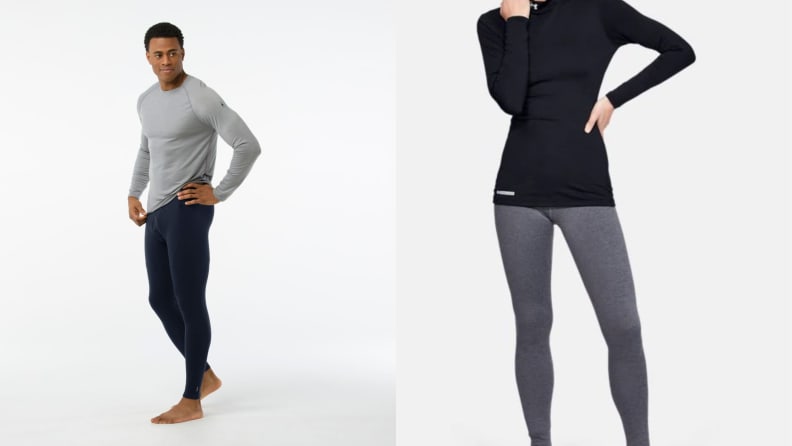
With the right base layer, your core temps will stay even.
Whether you opt for wool or synthetics, a thin, moisture-wicking base layer will help you maintain an even body temperature throughout the day. Smartwool’s merino base layers and Under Armour’s ColdGear are two great, well-reviewed options, depending on your personal preferences.
“Incredible shirt for snowboarding—no longer am I too cold or too hot,” writes a reviewer of Under Armour’s women’s ColdGear mock neck top. “This shirt regulates body temperature and wicks moisture like no other cold weather gear that I have had. I am already stocking up so I have extra this winter.”
- Get Merino base layers from Smartwool starting at $26
- Get Under Armour ColdGear base layers starting at $14.99
3. Snow pants to keep your legs dry and limber
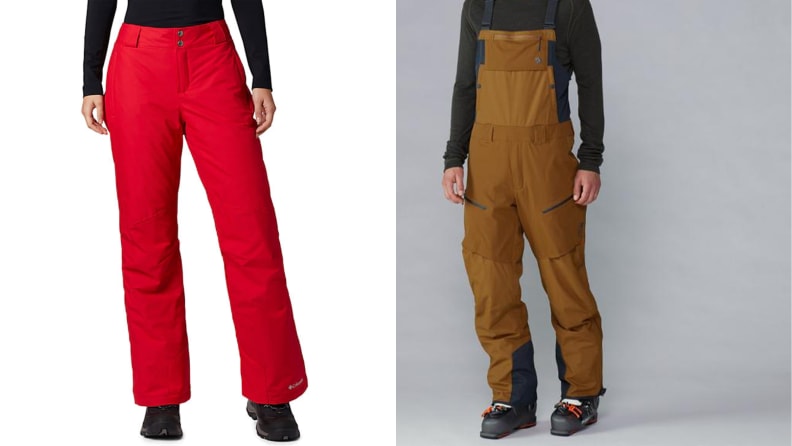
As long as your snow pants are insulated and waterproof, you should be good to go.
The ideal snow pants for a ski or snowboard day keep your legs warm, dry, and mobile. Both the Columbia Bugaboo and Mountain Hardwear FireFall are insulated, waterproof, and have a slight stylish flare. The main differences between them? The FireFall pants have a bib—which can prevent snow from sliding in on extra cold days—and the Bugaboo ones are more streamlined.
“I bought these because I was sick of low-cut women's snow pants that constantly let snow in and aren't very forgiving for a mom whose weight fluctuates a bit,” writes a reviewer of the FireFall pants. “These bibs are exactly what I was looking for! They are comfortable, fit perfectly, don't allow snow in and are warm.”
- Get Bugaboo Snow Pants in men’s sizes from Columbia for $110
- Get Bugaboo Snow Pants in women’s sizes from Columbia for $110
- Get Mountain Hardwear FireFall pants in men’s sizes from REI for $225
- Get Mountain Hardwear FireFall pants in women’s sizes from REI for $225
4. A jacket that leaves room for a helmet
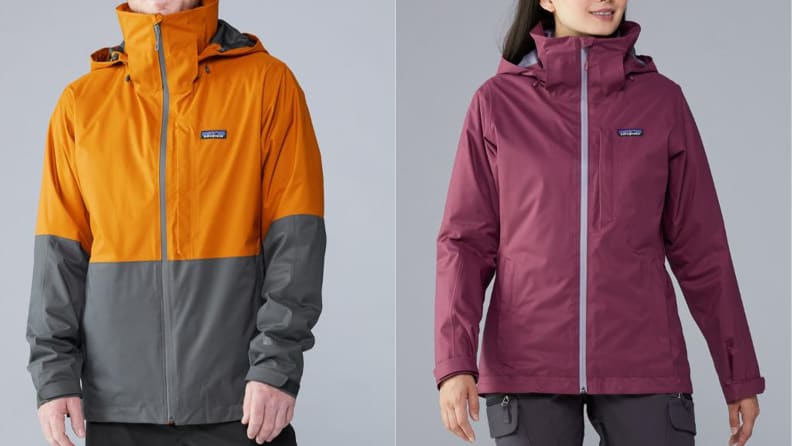
Look for a coat with a high collar and helmet-friendly hood.
You want your jacket to have a hood with room for a helmet, and a high neck to give you protection against the icy downhill winds. The L.L. Bean Rugged Ridge, Columbia Lay D Down and Alpine Action, and Patagonia Snowshot and Snowbelle jackets are all well-reviewed by skiers for their breathable warmth, detachable hoods, and high collars.
“I am very happy with this jacket. I use it for skiing in Cerro Catedral Argentina,” writes a reviewer of the Alpine Action jacket. “Withstands temperatures well below -20 degrees Celsius, snowfall and light rain. It is really comfortable, with several pockets to store the ski pass, wallet, glasses, and cell phone, the internal pocket has a little hole to pass by headphones cable.”
- Get the Rugged Ridge Parka in men’s sizes from L.L. Bean for $199
- Get the Rugged Ridge Parka in women’s sizes from L.L. Bean for $199
- Get the Lay D Down II Jacket in women’s sizes from Columbia for $230
- Get the Alpine Action Jacket in men’s sizes from Columbia for $170
- Get the Patagonia 3-in-1 Snowshot Jacket from REI for $399
- Get the Patagonia Snowbelle Jacket from REI for $399
5. Hand-warming accessories to avoid numb extremities
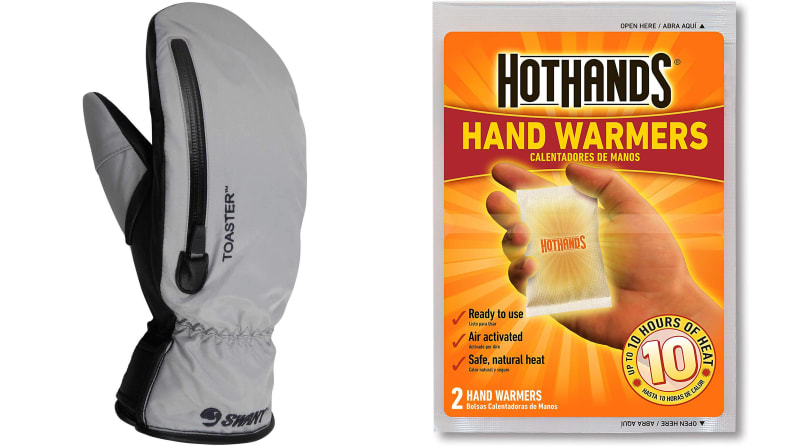
Mittens and hand warmers prevent your fingers from getting numb.
For the warmth of mittens and the dexterity of gloves, try Swany’s Toaster mittens, which have a gloved interior lining and a zippered pocket. “This is my second pair of these mittens,” writes a reviewer. “They are very lightweight, not bulky, but very warm. The zipper on the side is not only good for sliding in a hand warmer but also for bringing your fingers out (which are covered in the built in glove liner) if you need to zip your coat or use your phone.”
For extra warmth, put hand warmers in the mittens. All you have to do is shake them up and they’ll provide a heating effect for up to 10 hours.
- Get Swany Women's Toaster Mittens from Amazon for $53.71-$99.99
- Get Swany Men's Mittens from Amazon for $88
- Get Hot Hands on Amazon for $24
6. A gaiter or balaclava to keep snow off your neck
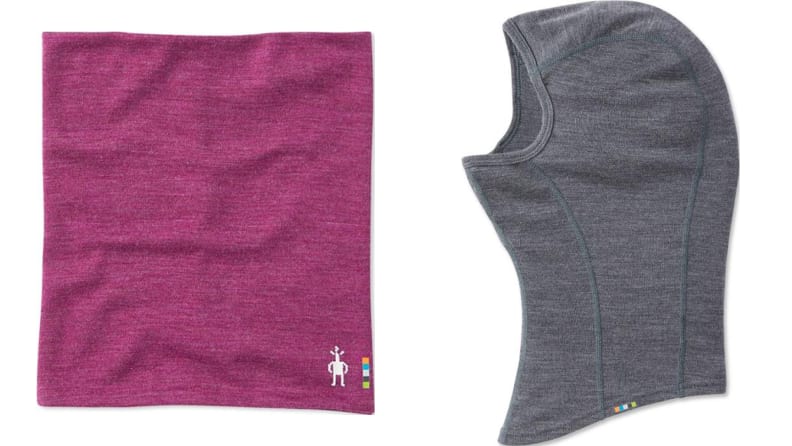
A gaiter or balaclava is a great barrier between your face and the icy winds.
A gaiter or balaclava made of wool or fleece keeps your neck insulated without too much bulk. Reviewers like Smartwool’s options, which are made of 100 percent merino wool and provide a fuzzy—but not itchy—feel. “This is probably my favorite piece of snowboarding gear,” writes a reviewer of the gaiter. “Keeps me warm through those powder days when there is just no way to keep all that snow out. By the end of the day, the gaiter is soaked through with melted snow, but I don't even notice because the wool stays warm regardless.”
7. Goggles and a helmet to protect your head
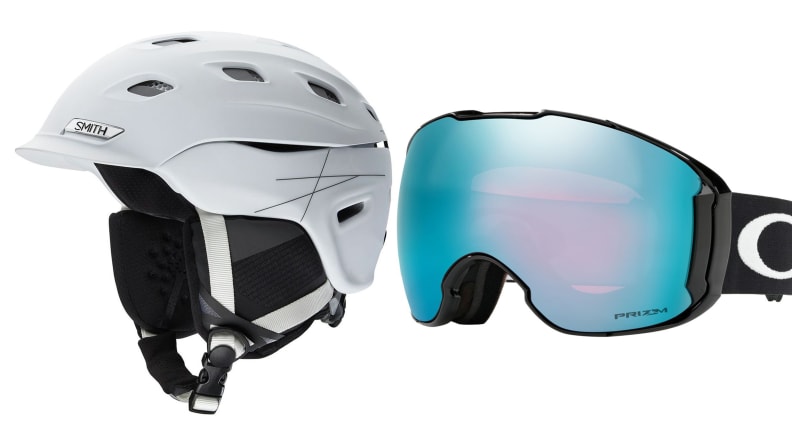
Protect your noggin with a helmet and goggles.
With all the potential hazards on the slopes—stray shards of ice, packed snow, and trees lining the trails—a pair of goggles and a helmet are essential for keeping the most important part of your body safe. If you want to fit in with others on the mountain, look for helmets and goggles from Smith, Giro, and Oakley. "What a difference from my old goggles," writes a reviewer of the Oakley Flight Deck goggles. "Better peripheral vision, visual clarity is outstanding, no fogging, fit my Smith helmet perfectly without any gaps, AND most importantly...they're so cool looking."
- Shop Smith helmets and goggles at Backcountry starting at $55
- Shop Giro helmets and goggles at Backcountry starting at $39.95
- Shop Oakley helmets and goggles at Backcountry starting at $50
8. SPF to get you through the day

SPF is vital to prevent itchy, flaky skin after a day of skiing.
UV rays are stronger the higher your elevation is, so you want to make sure you have a compact sunscreen and lip balm of at least SPF 30 to stick in your jacket pocket. For extra portability, go for an all-purpose stick—like Neutrogena’s Ultra Sheer Face & Body Stick—which can serve as protection for your face and lips. “I like these because it is easy to apply to my face and neck prior to long tennis bouts or skiing,” writes a reviewer. “I appreciate the ease of use, getting protection on my susceptible areas quickly and fully, which other (cylindrical) sticks can't manage to do.”
